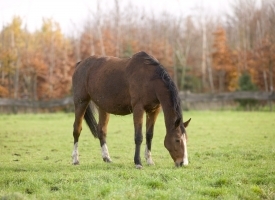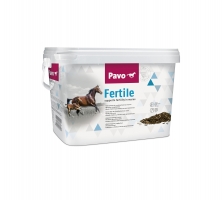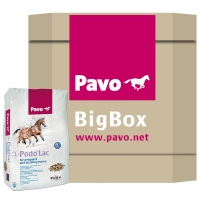|
Advice article filter
|
Pregnant mare: nutrition and laborFor every breeder, spring is an exciting, but also anxious time. In the run-up to the birth, it is a good thing to think about the feeding requirements of the mare before and after foaling, when she is lactating to the full. And what about riding a pregnant mare? Fertility and the mareTypically, a mare will start her cycles in early spring and will be in heat every three weeks up till September. The fertile period of the mare lasts 3 to 7 days. If the mare can’t spare sufficient energy, because she is in a poor condition or too thin, fertility problems can occur. In addition to regularity in daily life, good stable hygiene, sufficient exercise and a stress-free environment, the following vitamins and minerals can have a positive effect on the mare’s fertility:
The feed supplement Pavo Fertile contains, among other things, the abovementioned substances and can support the fertility of the mare. Mare in foal or lactating mare and roughageGrass contains the ideal nutrients for mares, however, roughage often contains much less proteins and minerals than people always thought. It also contains much less vitamin E than fresh grass. Poor roughage is good for fat horses and hardy breeds, but not for a lactating mare. Many mares only have access to grass late in the season and the grassland may then not always be sufficient to meet their feed requirements. Feeding only dried roughage is therefore not sufficient and will result in a deficiency of vitamin E, which in turn increases the risk that the placenta will be retained. Feeding the mare in foalDuring the first eight months of gestation, the mare’s normal diet will suffice, but during the last three months of gestation, the feed requirements of the mare change dramatically. During those last three months, the foal in the womb experiences a major growth spurt. The nutrients required for this growth are passed on to the foal in the uterus via the blood and after the birth through the milk. Deficiencies of certain nutrients can cause a disposition for leg problems such as OC or OCD. Pavo Podo® Lac was developed especially for mares in foal and lactating mares and contains all the vitamins, minerals and trace elements that are necessary for an optimum development and growth of the foal. Feeding during lactationPost birth, the mare’s requirements of energy and proteins increase enormously. During the first few days, a mare produces approximately eight litres milk per day, which gradually increases to twenty litres. A shortage of proteins is detrimental and will cause a reduced milk production. A lactating mare literally needs twice as much energy and proteins as a mare without foal. During the first three months of the lactation, you can continue to give your mare Pavo Podo® Lac. From three weeks onwards, the foal will start to eat pellets and as a result the ratio of the mare can gradually be decreased. As soon as the foal has been weaned, the mare can go back to the diet she was used to. Feeding a pregnant mare suffering from laminitisIt can happen that a mare in foal gets laminitis, or is prone to this. In that situation too, it is of utmost importance that the mare should get sufficient extra nutrients for the foal during the last three months of pregnancy. Put fat mares in foal on a diet?A mare should not be too fat during her pregnancy. The reason is that foals of fat mares grow faster which is not beneficial for the bone quality. However, it is not wise to put the mare on a diet after the ninth month, as the foal is then going through the largest development. You can make sure that she does not get fatter, but do not put your mare on a strict diet! More exercise is advisable, but it goes without saying that this should be adjusted to her condition. Riding a mare in foalIf there are no medical reasons as a result of which the risk of complications during the gestation and birth process increases, you can continue to exercise the mare as usual. Only in the last months of the gestation, the mare might get too heavy and/or her stamina and flexibility might decrease and you will have to adjust the intensity of your training schedule. Most importantly, you have to keep a close eye on your horse and use the signals that she gives to decide what she can still do. On the other hand, you should not all of a sudden stop exercising her, as it is indeed very healthy to exercise a mare until the last days - but don’t ride her any longer. After all, a good physical condition is a prerogative for an easy foaling process. |




